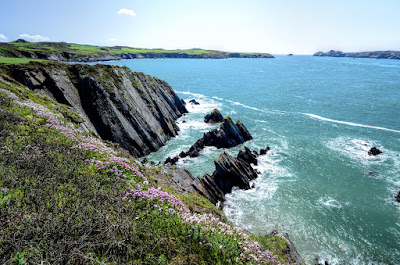Layla’s walking
up the hill again, up to the top of the Mountains that ‘flaunt themselves in
patchwork, fashioned by flora and weather. Green, brown, purple with the heather. Red with the dying sun, white in the
heat of the day. Only when the
rain clouds slink over the Bluff do they turn dark as blankets. But still they call them black.’
This is an
extract from one of my stories, currently featured in the online edition of
‘The Lonely Crowd’ magazine (thelonelycrowd.org). It’s great seeing it up there, and I’m particularly pleased
because it’s set in one of my favourite places – the Black Mountains, the hills in the eastern part of mid-Wales, sheltering the small town of Talgarth, where we
used to live. I always felt that
both the mountains and the town suffered from lying in the shadow of more
famous neighbours – the Brecon Beacons; and Hay-on-Wye, the town of books,
kings and emperors, and the greatest literature festival in the world. Talgarth was always being declared - by
estate-agents, anyway - ‘up and
coming’, and it’s well on the way now, with its highly-regarded mill/café
venture (as seen on TV!), and fashionable residents, such as Owen Sheers and the
guitarist from ‘Blur’. But I
loved it even back then, when it was in struggling small-town mode (closing
facilities, boarded-up houses)– and I especially loved the mountains that rose
above it.
Perhaps that’s
why they feature so much in my writing. The main character of half my
dual-narrative novel lives in a secluded house in the middle of them. My collection of what I call ‘folk’
tales is set in various locations in and around them. And now there’s ‘Queen’ – or as it was originally titled
‘Queen of the Black Mountains’.
In it, Layla
turns out to be a figment of the narrator’s imagination – just as both these
characters, and their ‘stories’ are figments of mine. But the hill Layla climbs is real enough, leading from
Talgarth, past the gates of what used to be the psychiatric hospital, and on,
up to the heights. And there are
plenty of other images, still perfectly clear in my mind, insinuating their way
onto the page. The Mace was the focal point of the Square, with a crowd of
gossiping old women a permanent fixture
outside. The Balloon Man
wandered about, and Nike cap girl. And I remember looking out of our bedroom
window soon after we moved and seeing the purple mountains, and thinking
‘they’re not black, at all’. I’ve
used this image here, and repeated it in several stories, just as I’ve done
with the freedom ‘Layla’ feels up on the mountain tops – something I myself always
experienced, the kind of emotion that only ‘being there’ might reveal.
Writing about the
topic of setting in ‘The Guardian’ recently, David Nicholls talked about
whether ‘being’ in a location was necessary for a writer, in these days of
virtual mapping on Google. His own
preference is for first-hand experience, but he quotes many examples of fine
novels, with perfectly-drawn, evocative settings, where it is well-documented
that the author never visited.
For me, place,
whether in fiction or real life, is to do with those emotional reactions, -
connections, one might say - which have the ability to colour our perception of
our surroundings and so influence our response to them.
I never really
liked Northamptonshire, or Buckinghamshire, where we also lived, although I
appreciated their ‘green and pleasant’ countryside, and their chocolate-box
villages. But I loved North
Wiltshire, and, in particular, its ‘mythical/mystical’ elements – Avebury Stone
circle and all the other megaliths strewn about the area; Silbury Hill; the barrows; the white
horses; the crop-circles (it never seemed to matter whether they were man-made
or not - walking into one of them, the woman in front turned to me, with an
ecstatic look on her face, saying ‘Can you feel the vibration!? Can you feel it!?’ Well, I couldn’t, but I still shared
her wonder). Avebury is the
setting of my Young Adult novel – a key aspect of which is how the three teen
characters view this mysterious environment. And I hope my own ‘connection’
will be conveyed to my teenage readers, and allow them to share in its magic.
 |
| Avebury Stones (photo courtesy of dp-multimedia ©) |
As a
writer, setting is a way of keeping the place with me, long after we’ve
departed, as it has been with those Black Mountains, left even longer ago.
I haven’t set
anything in Pembrokeshire yet, but I’m sure I will – that empathy for the
landscape certainly exists here. How
could it not, when I am surrounded by its spectacular, ever-changing coastline,
amazing wild-life, and its own sprinkling of magical stones? I’ve got a few ideas, idling in the
back of my mind, waiting to come to the fore. Waiting for the right moment. But not waiting for us to go from here, this time. Home – another sense of place
altogether. And perhaps the best
one of all.

No comments:
Post a Comment